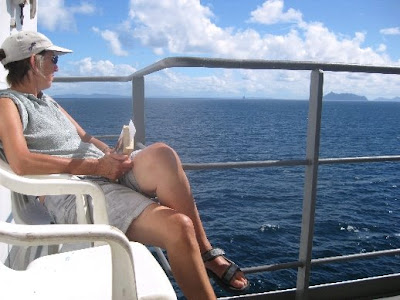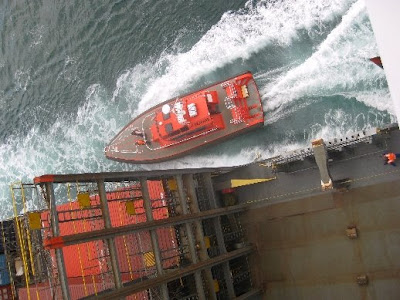A life on the Ocean Waves ...
Sunset over the pacific
A 23-day voyage across the Pacific Ocean on a container ship is a little out of the ordinary. It isn't a 'cruise'. Our ship, the Hansa Flensburg, an 18000 ton vessel with a capacity of about 1500 containers, plies the route from North America to the Australian ports of Sydney, Melbourne and Adelaide, calling in at Vancouver, Oakland, Long beach, Ensenada (Mexico), Papete (Tahiti) and New Zealand. It takes about two months to complete a tour, our leg from Melbourne to Ensenada taking 24 days. Stops in ports are mostly less than 24 hours so there is limited opportunity to explore and you are often quite a long way from the town without easy transport in to the town proper.
Accommodation is excellent situated on F-Deck just below the bridge. Our cabin consisted of a large lounge, a bedroom and a bathroom.
Our lounge
The lounge contained a VCR/DVD player as well as a desk, fridge, kettle and two sofas. - rather better than you usually get in a 3-star hotel. There were also a couple of small communal decks where we could sit in the sunshine (or shade) and read.
Sunshine on F-deck
We had more or less complete freedom to go where we wanted, although for'ard amongst the containers was dependent on good weather as this you could get washed off the deck in rough seas.
Life on board is regulated by meal times; breakfast at 0800, lunch (the main meal of the day) at 1200 and evening meal at 1800. Like Pavlov's dogs, you rapidly become conditioned and begin to salivate at the appropriate times. Food is pretty reasonable considering the variety of tastes, although there is not a great deal of choice. It would not suit vegetarians as many of the main meals consisted of meat balls in various guises. The calorie intake is potentially huge and we soon began to miss out the cooked breakfast. Even so, with the limited exercise we both put on weight. Our main exercise was the stairs – 84 – down (and up) to the dining room . This is hardly enough to burn off the calories consumed in the meal.
The Officers Dining Room
Our trip consisted of 2 days from Melbourne to Adelaide, 6 days on to Auckland, then 7 days to Tahiti and finally 9 days to Ensenarda. This allowed us to gradually get used to long spells at sea. We had taken a lot of books and other activities to provide our entertainment, and there was a large stock of books, videotapes and dvd's that we could borrow.
We began the voyage as the only passengers but picked up one at Adelaide and then another couple at Auckland. We met together for meals (along with the Captain and Chief Engineer) and at other times – just for a chat. Life on board begins to fall into a routine governed by meal times, mainly consisting of reading, watching films, chatting, sun bathing, visits to the bow and for Meg learning Spanish from a teach yourself CD, while for Jeff daily visits to the gym (or the grym, as he began to refer to it).
The 'grym'
What is remarkable is the way that life slows down. There are few demands, little enternainment, little to see (except sea). Meg described it as like an old peoples home with lots of stairs.
An evening barbecue on deck
It probably sounds very dull from the outside but in fact we were hardly ever bored and really reveled in the lack of feeling that we 'really should be getting on with (whatever)...' Leading busy lives, leisure without the underlying feeling of having to pay for it later is a rarity in our experience. We read extensively – both novels and 'serious' stuff, often falling into a guilt-free sleep in the process. We were allowed on the bridge at any time and we made visits several times each day (just to check that we were going in the right direction etc !)
On the Bridge
We could look at charts, radar screens, computer navigation tools etc and the crew were happy to explain things to us. The view from the bridge is wonderful, and the navigating into and out of ports – with a pilot on board – were some of the highlights of the voyage.
On Monday 6th April we crossed the international dateline and had to repeat the day again! This was a most strange experience. A notice appeared on the Poop Deck notice board
"Tomorrow will also be Monday"
It takes a bit of working through this to come to terms with it but we finally caught up all the hours that we lost crossing Europe, Asia and Australia, and we went from 12 hours ahead of UK time to 12 hours behind. We wondered if we should do the washing again or perhaps repeat the same conversations over breakfast. Airline pilots who fly USA to Australia routes must be very confused people.
One of our great treats was a daily visit to the bow. You could lean on the rails right at the 'pointy bit' with the warm wind rushing through your hair and flying fish jumping in the water in front of you.
The Main Deck
Meg playing 'Titanic' at the Bow
This experience is truly amazing! We would often spend an hour or so simply watching the ship cut its way through the ocean. The flying fish are remarkable. Up to about 6 inches long, they leap out of the water – sometimes in large groups - disturbed by the ship's shadow (which we assume they must percieve as some enormous predator).
They use their adapted fins as wings and glide above the water, occasionally appearing to run across the surface. Sometimes they are aloft for 30 seconds or so.
Both the Captain and the Chief Engineer were from New Zealand and we were grateful to the way in which they treated us as equals and talked freely about their times on ships. There were lots of humerous stories and much speculation on the pirates off the coast of Africa. We learned a lot about what it is like to be a ship's officer through our discussions over meals. Things have changed dramatically over the last forty years or so. For example, crews of 40 have dwindled to perhaps 13, and much of the art of navigating and controlling a ship has been 'eroded' by GPS systems and computers. It is easy to see the attractions of a life at sea, although also easy to see the negatives.
The remaining crew were a mixture of Ukranian, Kiribati and Phillipino – all very friendly and approachable although sometimes communication was a little difficult.
We all looked forward to arriving in port. The pilot arrives by launch when you appproach the prot and clambers up a rope ladder.
The PIlot Arriving
Being able to go on the bridge and watch the pilot direct the helmsman into or out of port was a real privilege. You see everything, and soon realise what a monster the ship is (and it is only a tenth of the tonnage of some large cruise ships). There are no emergency stops or three-point turns, and even at low speed and error could destroy half the dock as well as sink the ship. Tugs (and bow thrusters) are used to turn the ship around and gently nudge it towards the dock.
In Papete
In Aukland
Once the ship is in port customs officers arrive and check the paperwork and, sometimes, search the ship. After that we are free to leave and 'explore the town' while the monster cranes and 'straddlers' unload and reload the containers. This is so fast. The cranes is already moving well before the container is off the deck and the container is rapidly dropped onto a platform. Within seconds a straddler has drawn up above it and is driving off to drop the container in its designated slot in the port.
Would we do it again? The answer is a qualified yes but this may be the wrong time to ask us. It has been an enjoyable way to travel and to learn a lot, but we both fear that after three and a half weeks where the most difficult decision is how you want your eggs cooked for breakfast, we might not be able to function in the real world ever again. It is certainly travel on a much more 'human scale'. You really get the feeling for how far you go, how huge the ocean is and how enormous the planet is – something that is easily missed when travelling by plane. But it is not something you could sensibly include in an annual vacation while working full time.
Our last meal
So, next stop San Diego, but first we have to get over the border into US (always a challenge). Then it is overland by train to Boston (via Buffallo) ready for the final leg of this amazing journey.















1 comment:
What a delight, Meg'n'Jeff. I will miss your travelling tales, but much look forward to welcoming you home.
Post a Comment